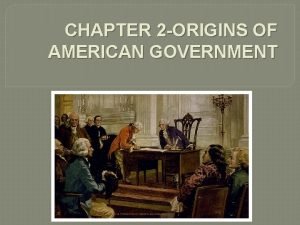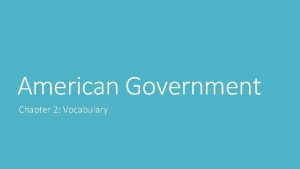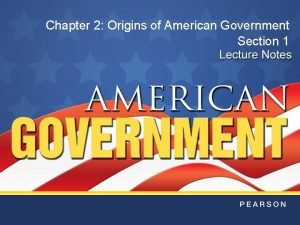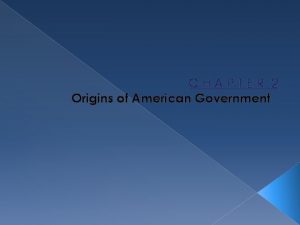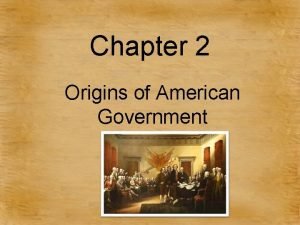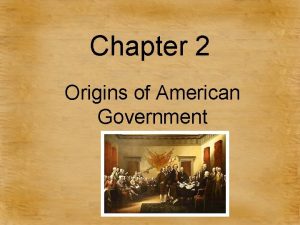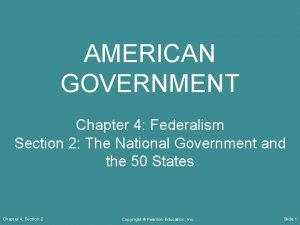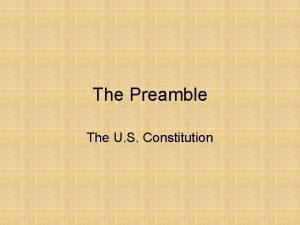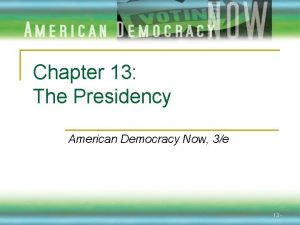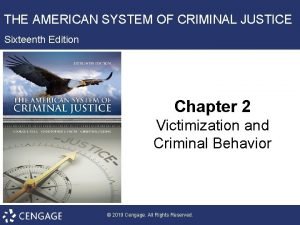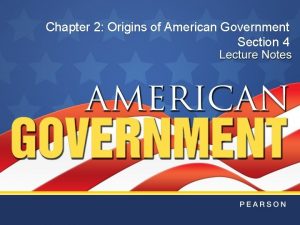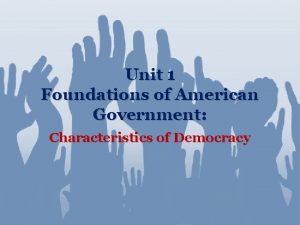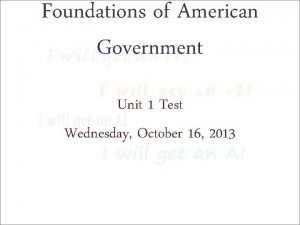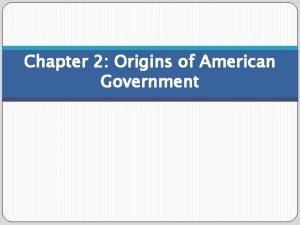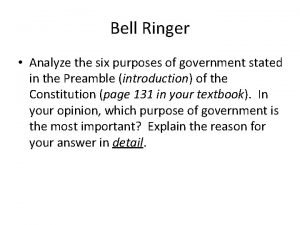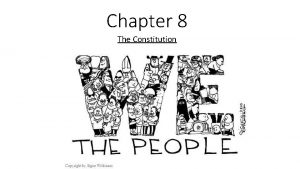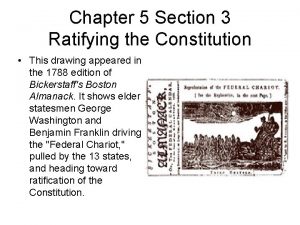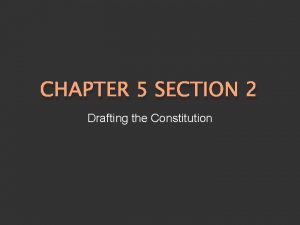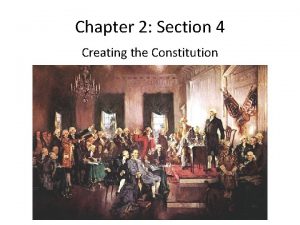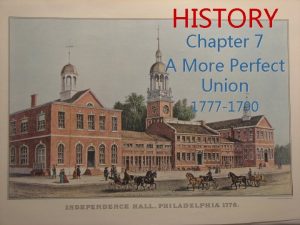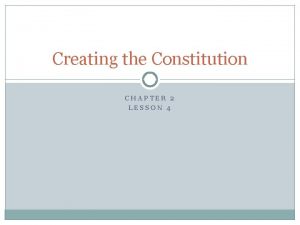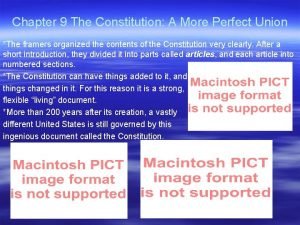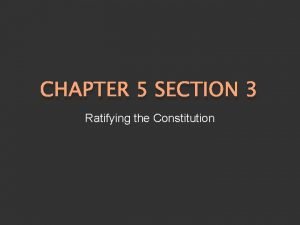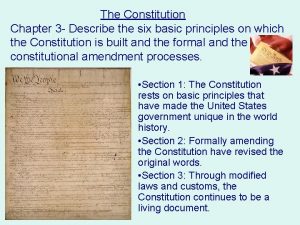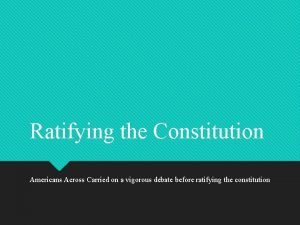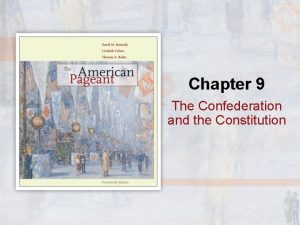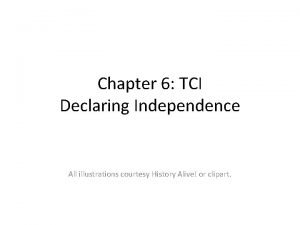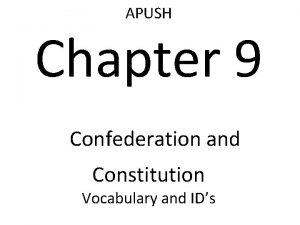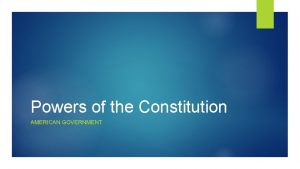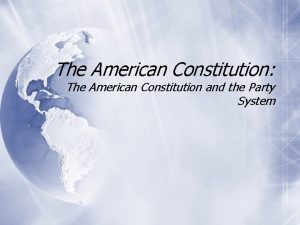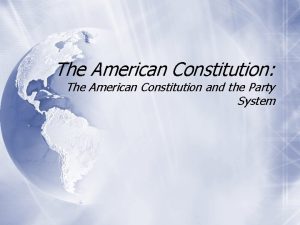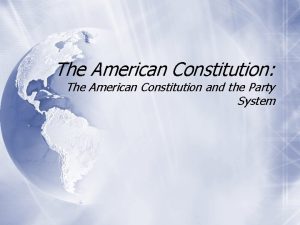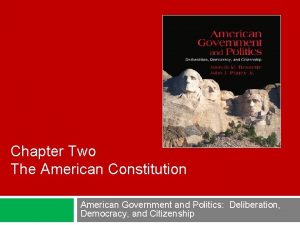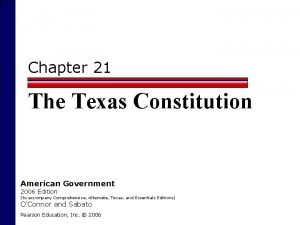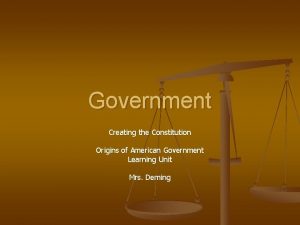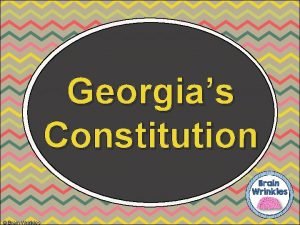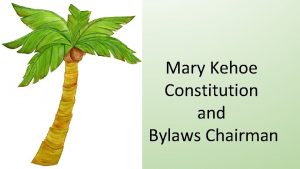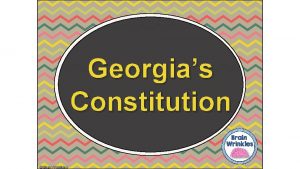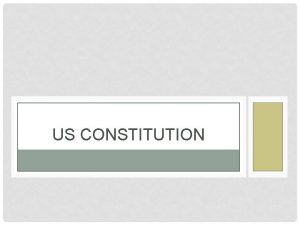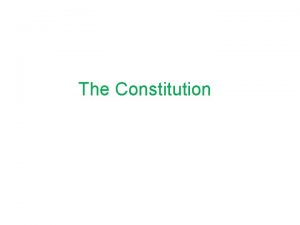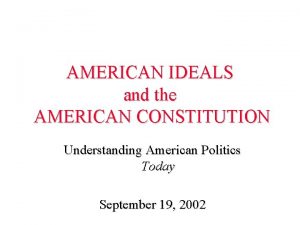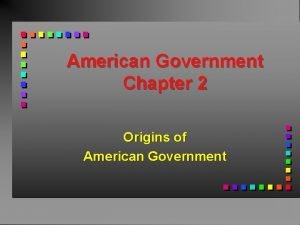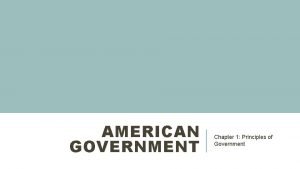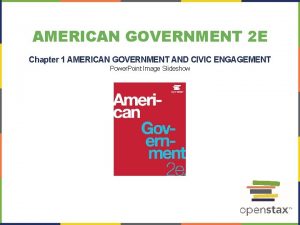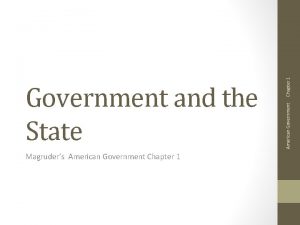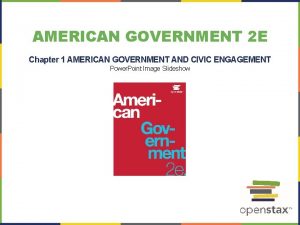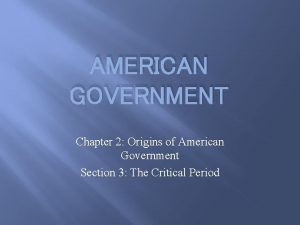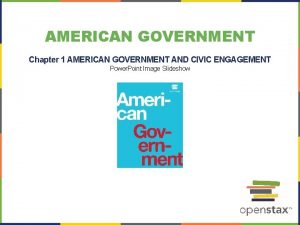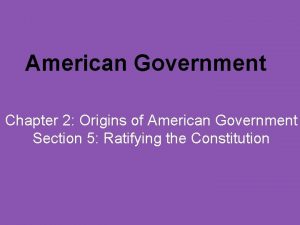Chapter 2 The Constitution American Government 2006 Edition








































- Slides: 40

Chapter 2 The Constitution American Government 2006 Edition To accompany Comprehensive, Alternate, Texas, and Essentials Editions O’Connor and Sabato Pearson Education, Inc. © 2006

The Preamble � We the People of the United States, in Order to form a more perfect Union, establish Justice, insure domestic Tranquility, provide for the common defense, promote the general Welfare, and secure the Blessings of Liberty to ourselves and our Posterity, do ordain and establish this Constitution for the United States of America � Schoolhouse Preamble

Woll #3, Charles Beard � How does Beard characterize the delegates of the Constitutional Convention of 1787?

Woll #3 (cont’d) � What were the views of the delegates to the Convention on democracy and equality, according to Beard?

First Attempt: Articles of Confederation � Compact among the thirteen original states that was the basis of their government ◦ Written in 1776; ratified in 1781 ◦ Created a national government with Congress empowered to �Make peace �Appoint officers for an army �Control the post office �Negotiate with Indian tribes

First Attempt: Articles of Confederation � Under the Articles ◦ Each state retained its independence and sovereignty, or ultimate authority ◦ One vote in the Continental Congress for each state, regardless of size ◦ Vote of nine states to pass any measure ◦ Vote of all states to amend Articles ◦ Selection and payment of delegates to the Congress handled by respective states legislatures

Problems Under the Articles: Where Do We Begin? � Lack of national sentiment; little unity � 1781 1789 was “critical period” ◦ ◦ Congress rarely could assemble quorum When they met, little agreement on policy Congress had no power to tax Economic turmoil Unenforceable trade agreements Chaotic regulation of trade among states and with foreign nations ◦ No provision of judicial system No property rights, citizens’ rights not protected ◦ No power over the state gov’ts and their citizens Lack of strong central government ◦ Crumbling economy

What do you think? 1. 2. 3. 4. The Articles of Confederation demonstrated a distrust of a strong national government. What were the historical and philosophical reasons for this distrust? What were the pos/neg consequences of a weak national government? Why do you think the smaller states were satisfied with government under the Articles of Confederation? Many people today distrust the federal government. In your opinion, is such distrust justified. Explain.

How did Shay’s Rebellion Sow the Seeds of Change? � � Although Daniel Shays and his men were defeated, their rebellion frightened many – including property owners. 1780: Massachusetts adopted a constitution that appeared to favor the wealthy. ◦ Property ownership required for voting and office holding ◦ Economy bad; banks foreclosed on farms of veterans ◦ Massachusetts law required payment of debts in cash ◦ Shays and 1500 armed, disgruntled farmers marched to Springfield. ◦ Congress called for militia; asked for state donations. All refused but Virginia. ◦ Private money used to raise militia

Achievements under Articles � Revolutionary War � Northwest Ordinance (1787), which defined the Northwest Territory (later became 5 states)

Miracle at Philadelphia � Congress passed resolution for the “sole and express purpose” of revision of the Articles. ◦ First day: Edmund Randolph and James Madison of Virginia proposed 15 resolutions creating an entirely new government. ◦ Others wished to stick to their task. ◦ Virginia Plan triumphed in the end.

Characteristics and Motives of the Framers � 55 of 74 delegates labored during the summer to create the Constitution. � All were men � Many were quite young. Franklin, 81 � Several owned slaves. � But were their “property interests” the motivating factor?

Framers vs. Founders Present (Framers) Absent George Washington Thomas Jefferson (Ambassador, Paris) James Madison (greatest influence on the organization of national gov’t) John Adams (Ambassador, Great Britain) Governeur Morris (PA) (drafted much of the Constitution) Patrick Henry (anti-strong nat’l gov’t. ; refused to attend; “smelt a rat”) Edmund Randolph (Gov. VA) – (introduced the Virginia Plan; refused to sign the Constitution) John Hancock (ratified the Constitution) Roger Sherman (CT Compromise) Samuel Adams (ratified the Constitution) George Mason (author of “free exercise clause” and Virginia Bill of Rights) Elbridge Gerry (refused to sign the Constitution) Ben Franklin Alexander Hamilton James Wilson (major Federalist in PA, later appt’d by Washington as justice of Supreme Ct. )

Main Motivations of the Framers (Constitution) � � First, they sought to create a new government capable of promoting commerce and protecting property from radical state legislatures. This became the constitutional basis for national control over commerce and finance, as well as the establishment of a national judiciary and a strong president. Second, the framers wanted to prevent what they saw as the "excessive democracy" of the state and national governments under the Articles of Confederation. This led to the constitutional ideas of bi cameralism, checks and balances and indirect elections of the president and Senate. Third, the framers, lacking the power to force the states or the public to accept the Constitution, sought to identify the principles (limited government, popular sovereignty; equality of opportunity; federalism) that would help get the support they needed for legitimacy and ratification. This became the basis for the popular vote of the House, and subsequently the Bill of Rights, added in 1791. Finally, the framers wanted to be certain that the government they created did not use its powers to pose even more of a threat to the people's liberty like some of the radical state legislatures that the framers had so despised. To prevent this from occurring, the principles of separation of powers and federalism came into the Constitution. ◦ Did you know they met in secret? The work they were doing was illegal!

Charles Beard � Throughout the second half of the 19 th century, the prevailing attitude toward the country's founders was increasingly that of veneration, almost hero‑worship. Like Moses receiving the 10 commandments, the founders came to be viewed as messengers from God who had created the Constitution without real difficulty and had created an almost perfect document for the good of the nation. � Charles Beard, a historian, in 1913 shattered this myth when he argued that the Founders were actually members of the social and economic elite (well bred, fed and read), not very interested in democracy and more motivated by purely selfish needs ‑ with the Constitution as the vehicles towards that end. Beard agreed with the Anti ‑Federalist charge that the Federalists were a self‑serving, landed and propertied elite class with a vested interest in creating a capitalist‑based system only to enrich themselves. � Beard claimed that northern businessmen feared a weak, decentralized government could harm their economic interest. Beard argued that the merchant class or rich must, in their own interest, either control the government directly or at least control the laws by which government operates. Beard argued that the Federalists wanted a strong national government to promote industry and trade, protect private property, and most importantly, ensure payment of the national debt. Beard also claimed that the Constitution had been imposed by undemocratic methods to prevent democratic majorities from exercising real power. He pointed out that there was never any popular vote on whether to hold a constitutional convention; furthermore, most people in the country (slaves, Indians, women; poor whites) were not even eligible to vote on the Constitution ‑ only about 1/6 th of the adult white male population actually voted for ratification (the delegates at the various state ratifying conventions had been selected by only 150, 000 of the approximately 4 million citizens. ) � In other words, Beard adhered to the elitist view of politics, claiming a small, landed elite started this country and has remained in power since. Of the 55 delegates that made it to Philadelphia, 42 were � Original members of the Continental Congress and 34 were practicing lawyers all male and well educated. � By the 1950's this viewpoint had fallen from favor; with many historians arguing that there was no clear link between the economic wishes of the Framers and the final document that was created. By 1969, historians were arguing that social class, rather than economic class was the main motivator of the framers, and the middle ‑class values of the time favored order and stability over radicalism.

The Virginia and New Jersey Plans � Virginia Plan ◦ Powerful central government � Three branches � Legislative � Executive � Judicial ◦ Two House Legislature � One house directly elected, other from those nominated by state legislatures ◦ A legislature with power to select the executive and judiciary � New Jersey Plan ◦ Strengthening the Articles, not replacing them ◦ Creating a one house legislature with one vote for each state with representatives chosen by state legislatures ◦ Giving Congress the power to raise revenue from duties and postal service ◦ Creating a Supreme Court appointed for life by the executive officer

Questions to consider � What are the adv/disadv of having 2 houses of Congress? Explain what position you would take on this position? � Why do you suppose the Virginia Plan gave Congress the power to strike down laws made by state legislatures? What arguments could you make for or against giving Congress this power? � In what ways does the Virginia Plan correct what the Framers perceived to be weaknesses in the Articles of Confederation?

Constitutional Compromises over Representation and Slavery � Great Compromise ◦ One house of legislature: there would be 56 representatives, each directly elected by people �Would have power to originate all bills for raising and spending money ◦ Second house of legislature: each state should have an equal vote, and representatives selected by the state legislatures ◦ National power would be supreme � Three Fifths Compromise ◦ “three fifths of all other Persons” ◦ Assured South would hold 47 percent of the House

Drive for Ratification � Second Continental Congress accepted the work of the convention. ◦ Forwarded the proposed Constitution to the states for their vote ◦ Debated hotly by the Federalists and Anti Federalists

Federalists versus Anti-Federalists � Federalists ◦ Favored a stronger national government and supported the proposed Constitution ◦ Later became the first political party in the U. S. � Anti Federalists ◦ Favored strong state governments and a weak national government ◦ Opposed the ratification of the U. S. Constitution

Federalism vs. Antifederalism Federalists Anti-Federalists Who are they? Property owners, landed rich, merchants of Northeast and Middle Atlantic states. Small farmers, shopkeepers, laborers. Political philosophy Elitist: saw themselves and those of their class as most fit to govern (others were to be governed). Believed in the decency of the common man and in participatory democracy, viewed elites as corrupt; sought greater protection of individual rights. Type of government favored Powerful central government; twohouse legislature; upper house (sixyear term) further removed from the people, whom they distrusted. Wanted stronger state governments (closer to the people) at the expense of the powers of the national government; sought smaller electoral districts; frequent elections, referendum and recall, and a large unicameral legislature to provide greater class and occupational representation. Alliances Pro-British, Anti-French Anti-British, Pro-French

The Federalist Papers � Series of 85 political papers written by John Jay, Alexander Hamilton, and James Madison ◦ Supported the ratification of the Constitution ◦ Hamilton wrote 51, Madison wrote 26, Jay wrote 5 ◦ Appeared in newspapers where ratification was in doubt ◦ Brutus and Cato among others versus Publius

The Federalist Papers � Anti Federalists feared a strong central government would render states powerless. ◦ ◦ ◦ Feared that liberties of people would be trampled Wanted to limit taxing power of Congress Curb executive with a council Military consist of state militia rather than a national force Limit Supreme Court power to review decisions made by states

Federalist #51 Questions 1. 2. 3. 4. Madison says, “If a majority be united by a common interest, the rights of the minority will be insecure. ” Why does he say that majority rule could destroy the rights of minorities? How does Madison propose to protect the rights of minorities against tyranny by the majority? Would Madison have agreed with the proposition: Government must be strong enough to protect the rights and liberties of citizens, but not strong enough to suppress those civil liberties. Explain. Did Madison believe that citizens could lose their rights and liberties if government were too weak? Explain.

Federalist Paper #51 � � The founders were generally supportive of separation of powers (the institutional arrangement that assigns judicial, executive, and legislative powers to different persons or groups, thereby limiting powers of each), some form of which appeared in all the state governments. Not so readily accepted was the notion of checks and balances (principle that allows each branch of government to exercise some form of control over the other), that once the power was separated, it should somehow be shared. The trick was to give people in each branch in interest in controlling the behavior of others. This is how human nature, flawed though it might be, could be used to limit the abuses of power. As Madison states, “Ambition must be made to counteract ambition. ” Thus, there was no danger in sharing some control over the branches because jealous humans would always be looking over their shoulders for potential abuses.

Choose a Side � Imagine you’re alive during the framing of the Constitution – which side would you choose: Federalist or Anti Federalist? Explain.

Unfinished Business � One person executive ◦ Term of office ◦ Committee on Unfinished Portions �Purpose to iron out problems and disagreements concerning the office of chief executive �Recommended fixed term of four years, not seven ◦ Electoral College ◦ Removal of the Chief Executive �Treason, Bribery, or other high Crimes and Misdemeanors

Ratifying the Constitution � Three states acted quickly to ratify the Constitution. ◦ Delaware, New Jersey, and Pennsylvania. ◦ Massachusetts assented, but wanted amendments to protect individual rights. ◦ New Hampshire: crucial ninth state to ratify on June 21, 1788. ◦ NY and VA had not ratified, but would. ◦ North Carolina and Rhode Island still held out. �Worried about their new currency and its value upon ratification. �NC rejected the Constitution on basis of no Anti Federalist amendments were included. �Congress submitted the Bill of Rights to the states for ratification in September 1789

The U. S. Constitution: Basic Principles � Separation of Powers ◦ Way of dividing power among three branches of government ◦ Members of branches are selected by and responsible to different constituencies � Checks and Balances � Federal System ◦ Gives each of the three branches of government some degree of oversight and control over the actions of the others ◦ Plan of government created by Constitution in which power is divided between the national government and the state governments and in which independent states are bound together under one national government

Legislative Executive Judicial Legislative Makes Federal Laws. Institutes and collects taxes, duties to pay off debts, provide for the common defense and spend for the general welfare of the nation. Coins & borrows Money. Regulates commerce between the states (interstate commerce) as well as with foreign nations and native tribes. Establishes post offices and promotes scientific progress. Creates the lower federal courts as needed (some of these are Constitutional, some are Legislative in nature). Establish the requirements of Citizenship. Recommends laws, constitutionally this function derives itself from the requirement for the president to make a State of the Union Address, but we also find examples in this from bills submitted by the executive to Congress. Can veto congressional legislation after it comes to him in the same form from both houses of congress (Enrolled). This is subject to an override if 2/3 rds of both Chambers vote to do so. Can call Congress into special sessions. Applies and Interprets Congressional Statutes. (statutory interpretation) Applies and Interprets the Constitution as it regards to statutes, declaring them Unconstitutional if they are in violation of the test or modern interpretation of the Constitution. Executive Can override the veto of the President (both chambers voting with a 2/3 rds majority). Can refuse to confirm appointments (judicial positions, cabinet and bureaucratic positions, ambassadors etc. ) made by the President. (Senate) Can call for (House) and try (Senate) impeachment against the President. Can refuse the ratify presidential treaties (Senate). Declares War. Responsible for implementing the laws passed by congress. Speaks with the voice of the nation to other nations. Receives Ambassadors from foreign nations (and consequently recognizes foreign governments as legitimate as a result). Makes treaties with foreign nations. Commander-in-chief of the United States military. Appoints the heads of various bureaucratic departments (in practice, these are the cabinet officials, although they are not specifically called for by the Constitution). Applies and Interprets the Constitution as it regards to actions of the President (executive orders, presidential commands, etc. ), declaring them Unconstitutional if they are in violation of the test or modern interpretation of the Constitution. Swears in Presidents. (Chief Justice)Presides over impeachment trials in the Senate. (Chief Justice) Judicial Can eliminate or refuse to create lower levels of the Court system. Can refuse to implement Court decisions. Can alter the jurisdiction of the federal Courts (with the exception of the Original Jurisdiction of the Supreme Court). Can alter the size of the Court (i. e. change the number of seats both upwards and downward). Can Impeach Judges. Confirms Federal Judges for their positions upon Presidential Nomination (or refuses to do so). Can alter the retirement package and salary of Judges (only upward, not downward). Can appoint federal Judges Can refuse to implement Court decisions Can give pardons to individuals or groups of individuals Applies and Interprets the Constitution as it regards to actions of the other branches of government, declaring them Unconstitutional if they are in violation of the test or modern interpretation of the Constitution. Applies and Interprets Statutes of Congress, state legislatures and localities. (statutory interpretation)

Powers of the Gov’t. Type of Power Where? What? Enumerated (delegated) to the national government Art. 1 Sect 8, Art. 3 Sect 2 and others, Art 3 Sect 2 of the Constitution Power to make war, to establish post office, to regulate interstate and foreign commerce, to coin money Enumerated (delegated) to the state governments Art 1 sect 4, art 2 sec 1, art 5, and other sections Power to establish state and local gov’t. , to conduct elections, to ratify constitutional amendments Reserved to (retained by) the state governments 10 th amendment Powers not delegated to the national gov’t. by Constitution or prohibited to the states by the Constitution Concurrent in (shared by) the national and state governments Constitution plus traditional practice Power to tax to spend to build roads to regulate business Implied to the national government (elastic clause, necessary and proper clause) Constitution as interpreted by Supreme Court in Mc. Culloch v. Maryland Any power that is an appropriate non prohibited means to a legitimate end (Congress had the power to incorporate the bank and that Maryland could not tax instruments of the national government employed in the execution of constitutional powers) Inherent in the national government Supreme Court in U. S. v Curtiss-Wright POTUS’ power to regulate arms sales (POTUS is representative of the nation) Denied to the national government Art 1 Sec 9 and Bill of Rights Ex post facto laws (outlawing something after it’s done. Bill of attainder laws declaring sb guilty and prescribing a penalty without a trial, others specified in first 8 amendments Denied to the state Art 1 sec 10 of constitution and supreme court when it made the bill of rights apply to the states. Make treaties coin money, regulate interstate commerce, refuse to treat citizens of other states equally with their own.

The Articles of the Constitution � Article ◦ ◦ ◦ ◦ 1: The Legislative Branch Powers of legislative branch Bicameral legislature Qualifications for holding office Terms of office Methods of selection System of apportionment Section 8 carefully lists the enumerated powers – 17 specific powers ◦ Necessary and Proper Clause �Elastic clause – basis for implied powers

The Articles of the Constitution � Article ◦ ◦ ◦ II: The Executive Branch Vests the executive power in a president Sets the president’s term at 4 years Explains the Electoral College States the qualifications for office Describes the mechanism to replace the president in case of death, disability, or removal ◦ Powers and duties found in Section 3 �Commander in chief, authority to make treaties with Senate consent, appointment power, State of the Union, and the “take care” clause, removal of the president

The Articles of the Constitution � Article III: The Judicial Branch ◦ Establishes a Supreme Court and defines its jurisdiction ◦ Supreme Court was given power to settle disputes between states or between national government and states. ◦ Ultimately, Supreme Court would determine what provisions of the Constitution actually meant.

The Articles of the Constitution � Articles IV Through VII ◦ Attempted to anticipate problems that might occur in the operation of the new national government and relations it had with the states. ◦ Article IV: Full Faith and Credit Clause �States honor the laws and judicial proceedings of other states �Mechanisms for admitting new states to the Union

The Articles of the Constitution � Articles IV Through VII ◦ Article V specifies how amendments can be added to the Constitution. ◦ Article VI contains the Supremacy Clause. �Provides that the “Constitution, and the laws of the United States” as well as all treaties are to be the supreme law of the land. �Also specifies that no religious test shall be required for holding office. ◦ Article VII concerns the procedures for ratification of the new Constitution. �Nine of thirteen states would have to agree to, or ratify, its new provisions before it would become the supreme law of the land.

Amending the Constitution

Amending the Constitution: The Bill of Rights � First ten amendments to the U. S. Constitution ◦ Specific protections of personal rights �Freedom of expression, speech, religion, and assembly �Right to bear arms and no quartering of soldiers responses to British rule �Ninth Amendment: enumerated rights are not inclusive �Tenth Amendment: powers not given to the national government are reserved by the states or the people

Methods of Amending the Constitution � Method of Proposal ◦ By two thirds vote in both houses of Congress, or ◦ By national constitutional convention called by Congress at the request of the state legislatures � Method of ratification ◦ By legislatures in three fourths of the states ◦ By conventions in three fourths of the states

Informal Methods of Amending the Constitution � Judicial Interpretation ◦ Marbury v. Madison (1803) ◦ What should govern judicial interpretation? �Framers’ intent? �Elastic, flexible document that could conform to ages? � Social and Cultural Change � Presidential Power � Actions of Congress
 Texas constitution vs us constitution
Texas constitution vs us constitution Nc constitution vs us constitution
Nc constitution vs us constitution Constitution what is constitution
Constitution what is constitution Lesson 1 principles of the constitution
Lesson 1 principles of the constitution 6 principles of the constitution
6 principles of the constitution Flocabulary 3 branches of government
Flocabulary 3 branches of government Chapter 2 american government
Chapter 2 american government Chapter 2 origins of american government vocabulary
Chapter 2 origins of american government vocabulary Chapter 2 origins of american government answer key
Chapter 2 origins of american government answer key Chapter 2: origins of american government worksheet answers
Chapter 2: origins of american government worksheet answers Chapter 2 lesson 1 origins of american government
Chapter 2 lesson 1 origins of american government Chapter 2 origins of american government
Chapter 2 origins of american government American government chapter 4
American government chapter 4 Preamble of the constitution definition
Preamble of the constitution definition American constitution
American constitution Using mis (10th edition) 10th edition
Using mis (10th edition) 10th edition Using mis 10th edition
Using mis 10th edition State and federal constitutions
State and federal constitutions Chapter 13 the presidency
Chapter 13 the presidency The american system of criminal justice 16th edition
The american system of criminal justice 16th edition Criminal justice wedding cake diagram
Criminal justice wedding cake diagram Origins of american government section 4
Origins of american government section 4 Ap us government and politics unit 1 study guide
Ap us government and politics unit 1 study guide Unit 1 foundations of american government
Unit 1 foundations of american government Origins of american government section 1
Origins of american government section 1 Foundations of american government unit test
Foundations of american government unit test Origins of american government section 1
Origins of american government section 1 What are the six purposes of government
What are the six purposes of government Lesson 1 structure and principles of the constitution
Lesson 1 structure and principles of the constitution Chapter 5 section 3 ratifying the constitution
Chapter 5 section 3 ratifying the constitution Chapter 5 section 2 drafting the constitution
Chapter 5 section 2 drafting the constitution Section 4 creating the constitution
Section 4 creating the constitution Chapter 7 lesson 2 forging a new constitution
Chapter 7 lesson 2 forging a new constitution Chapter 2 lesson 4 creating the constitution answer key
Chapter 2 lesson 4 creating the constitution answer key Chapter 9 the constitution a more perfect union
Chapter 9 the constitution a more perfect union Ratifying the constitution chapter 5 section 3
Ratifying the constitution chapter 5 section 3 Chapter 3 section 1 constitution scavenger hunt answers
Chapter 3 section 1 constitution scavenger hunt answers Chapter 5 section 3 ratifying the constitution answer key
Chapter 5 section 3 ratifying the constitution answer key Chapter 9 the confederation and the constitution
Chapter 9 the confederation and the constitution Tci declaration of independence
Tci declaration of independence Chapter 9 confederation and constitution
Chapter 9 confederation and constitution






